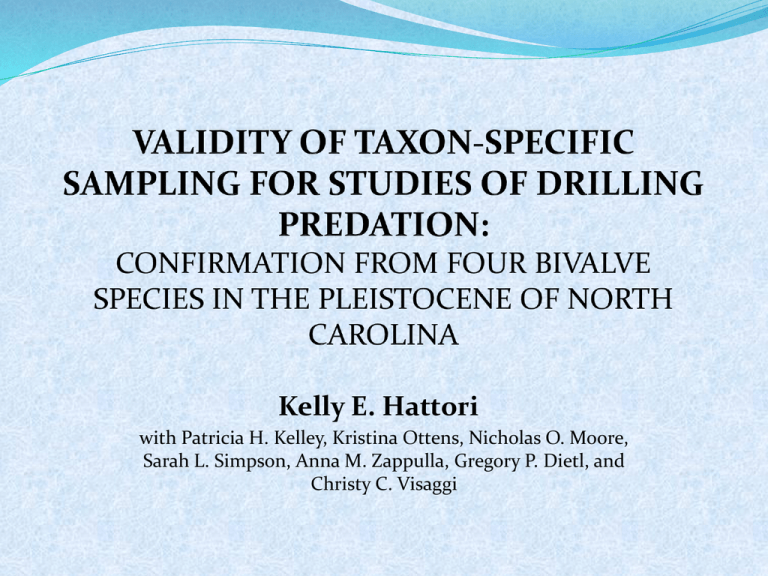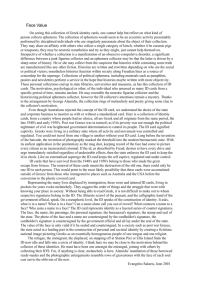Kelly_Hattori_GSA2013Powerpoint_Final
advertisement

Kelly E. Hattori with Patricia H. Kelley, Kristina Ottens, Nicholas O. Moore, Sarah L. Simpson, Anna M. Zappulla, Gregory P. Dietl, and Christy C. Visaggi BACKGROUND Predatory gastropods frequently feed upon bivalves Predation trace fossils occur in fossil record Drilling predation studies useful for examining community composition and interactions Many sampling method options, including: Bulk Taxon-specific (targeted) Surveys (museum, monograph, outcrop) RESEARCH GOALS Investigate: 1. Validity of taxon-specific (targeted) sampling as an alternative to bulk sampling when select taxa are needed for drilling predation studies Based on preliminary study conducted by Ottens et al. (2012) 2. Effects of collector expertise on bias in targeted samples 3. Effects of size variability of specimens on bias in targeted samples GENERA STUDIED / LOCALITY A B C D Lirophora latilirata (A) Cyclocardia granulata (B) Astarte concentrica (C) Glycymeris americana (D) Location of Register Quarry in NC COLLECTION METHODS Six bulk sample replicates taken during a Research Experiences for Undergraduates project in June 2008 Sieved using 5mm mesh ~ 2 liters of material per sample Each collector took five replicate targeted samples 1m2 quadrat size 25 specimen minimum per sample Layout of Register Quarry with location of targeted replicates MEASUREMENTS & CALCULATIONS Measured: Length and thickness Valve frequency (left versus right) Drillhole presence, location, and outer borehole diameter Calculated: Drilling frequency (DF) Diagram of drillhole location sectors from Kelley (1988) Prey effectiveness (PE) Size and site selectivity Size-standardize data using parameters used by Ottens et al. (2012) STATISTICAL TESTS & ANALYSIS Methods and collector experience for both standardized and unstandardized data Replicates analyzed in four groups: 1. All replicates separate 2. All replicates with a minimum of 10 specimens 3. All replicates with a minimum of 20 specimens 4. All replicates combined Mann-Whitney U tests, chi-squared tests, KolmogorovSmirnov one-sample tests, covariance tests RESULTS –Drilling Predation Metric Collector Standardized Collector Unstandardized 0.6% (n=1) 99.4% (n=165) 4.7% (n=16) Number of tests conducted: 1090 95.3% (n=322) Method Standardized Size-standardized data show fewer significant differences than unstandardized data Method Unstandardized 2.6% (n=5) Total specimens collected: 6826 10.4% (n=41) Taxon-specific 97.4% (n=188) sampling minimally significantly different from bulk sampling results 89.6% (n=352) Significant Non-significant RESULTS - Taxon Percentage of significant tests for each taxon Size variability 16.7 16 Percentage of Significant Tests of Glycymeris americana did not cause additional bias in collected targeted samples 18 15.1 14 12 10 8.3 7.1 8 6 6.8 5.2 4.6 4.8 4.5 4 2.2 Bulk samples frequently had inadequate sample sizes, especially in less common taxa 2 0 0 0 0 0 0 0 Astarte Method Unstandardized Cyclocardia Method Standardized Novice Veteran Bulk Lirophora Taxon Collector Unstandardized Glycymeris Collector Standardized Astarte Cyclocardia Lirophora Glycymeris 358 203 348 310 502 205 354 758 59 31 470 582 Percentage of Significant Tests RESULTS – Collectors 14 Percentage of significant tests for each veteran collector 12 10 Novice collectors 11.9 did not differ significantly from veteran collectors 9.1 8 6.8 6 4.8 4.3 2.9 4 2 0 PK GD CCV Veteran Collector Method Unstandardized Method Standardized Percentage of significant tests for each novice collector 18 Percentage of Significant Tests 16 15.9 14.0 13.6 14 11.3 12 10.0 10 9.7 8 6 4.8 4.9 4.7 5.8 5.0 4 0 1.7 1.6 2 0 0 KEH Method Unstandardized 0 NOM 0 SLS Novice Collector Method Standardized 0 AMZ Collector Unstandardized 0 0 KO Collector Standardized CONCLUSIONS 1. Taxon-specific sampling is a viable collection method for drilling predation studies in targeted species Limitations must be fully understood Care must be taken to avoid bias Sample size can be controlled More efficient CONCLUSIONS 2. Novices are able to collect samples of the same caliber as those collected by veteran collectors. Must be properly trained in identification, collection, and measurement techniques More efficient Larger pool of people to assist with studies Thank You!






